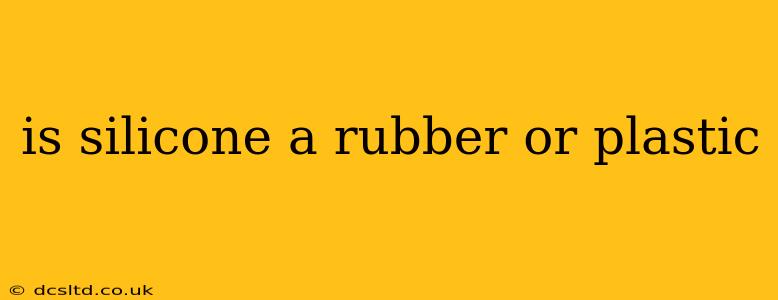Is Silicone a Rubber or a Plastic? The Surprisingly Complex Answer
The question of whether silicone is a rubber or a plastic isn't easily answered with a simple "yes" or "no." It's more accurate to say that silicone possesses characteristics of both, but ultimately sits in a category of its own. Understanding this requires delving into the material's unique properties and chemical structure.
What is Silicone?
Silicone, or polysiloxane, is a synthetic polymer made up of a silicon-oxygen backbone chain. These chains are often modified with various organic groups, giving silicone its diverse properties. This fundamental structure distinguishes it from both traditional rubbers and plastics.
Silicone vs. Rubber: Shared Traits and Key Differences
Silicone shares some similarities with rubber, specifically in its flexibility and elasticity. Many silicone products, like silicone rubber bands or seals, exhibit rubber-like behavior, stretching and returning to their original shape. However, the crucial difference lies in their chemical makeup. Natural rubber and many synthetic rubbers are based on carbon-carbon chains, whereas silicone's backbone is silicon-oxygen. This difference significantly impacts its properties.
Silicone vs. Plastic: Similarities and Distinctions
Silicone also shares some characteristics with plastics. Like some plastics, silicone can be molded into various shapes and forms. Some silicone materials are even relatively rigid, unlike typical rubbers. The key difference here again comes down to its chemical composition and resultant properties. Plastics are generally composed of long hydrocarbon chains, often with significant variation in their chemical structure depending on the type of plastic. Silicone's unique silicon-oxygen backbone gives it a distinct set of properties.
What Makes Silicone Unique?
Silicone's unique properties stem from its chemical structure:
- Heat Resistance: Silicone can withstand significantly higher temperatures than many rubbers and plastics.
- Low Temperature Flexibility: Unlike many other materials, silicone remains flexible even at very low temperatures.
- Water Repellency (Hydrophobicity): Silicone has excellent water-repellent properties.
- Inertness: It is chemically inert, meaning it doesn't readily react with other substances.
- Biocompatibility: Many silicone materials are biocompatible, making them suitable for medical applications.
These properties make silicone ideal for a wide array of applications, from cookware and medical implants to electronics and personal care products.
So, is it a rubber or a plastic?
The answer is neither, strictly speaking. Silicone occupies a unique space in the world of materials. While sharing some characteristics with both rubbers and plastics, its distinct chemical structure and properties set it apart. It's more accurate to classify silicone as a siloxane polymer—a distinct class of materials with its own set of advantages and applications.
Frequently Asked Questions:
H2: What are the different types of silicone?
There's a wide range of silicone materials, each with different properties achieved through variations in the organic groups attached to the silicon-oxygen backbone. These variations influence the material's hardness, elasticity, viscosity, and other properties, leading to diverse applications.
H2: Is silicone safe?
The safety of silicone depends on the specific application and formulation. Generally, silicone is considered a safe material for many uses, including food contact, medical devices, and cosmetics. However, it's essential to check for certifications and regulatory approvals to ensure safety in specific applications.
H2: How is silicone made?
Silicone is synthesized through a complex chemical process involving the reaction of organochlorosilanes. This process allows for control over the chain length and the type of organic groups attached, thereby fine-tuning the properties of the resulting silicone material.
H2: Can silicone be recycled?
Recycling silicone is currently limited. The process is complex and often not economically viable. However, ongoing research aims to improve silicone recycling technologies.
In conclusion, while silicone shares superficial similarities with rubbers and plastics, it stands alone as a remarkable material with a unique set of properties thanks to its distinctive silicon-oxygen backbone. Understanding this distinction is crucial for appreciating its widespread and versatile applications.
